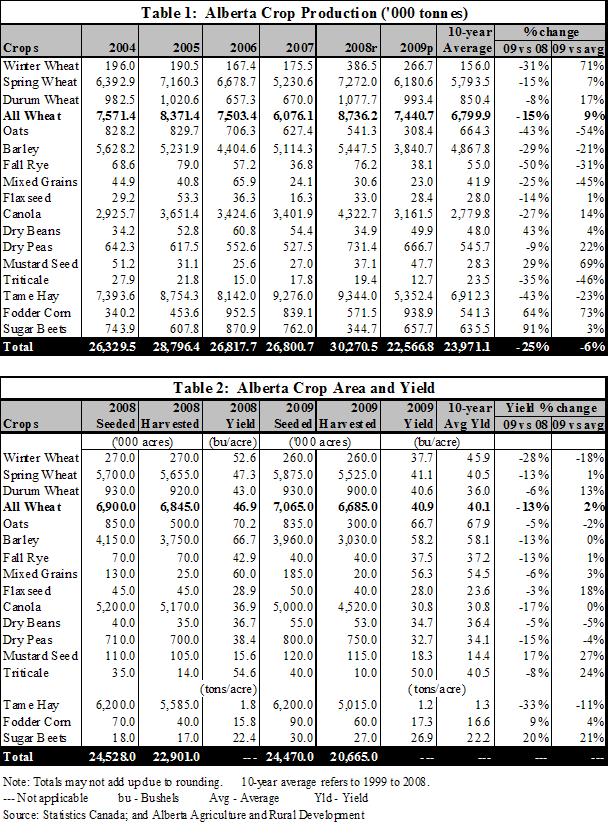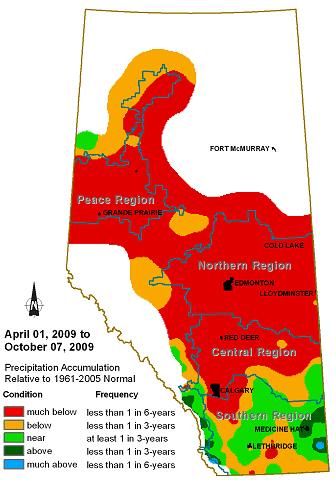| | The 2009 Crop season | Insects and crop diseases | Forage and pasture | Alberta crop production, 2009 | Alberta forage production, 2009 | Alberta crop production tables | Precipitation Map
This report presents a review of the 2009 crop season and an analysis of 2009 crop production statistics. In addition, a precipitation map for the 2009 crop season is attached for reference.
The 2009 Crop Season
Unfavorable crop growing conditions in 2009, particularly the cool, dry spring, took a toll on crop production in Alberta. Due to lower yields and smaller harvested area, total production of principal field crops in the province was down significantly from the record set in 2008.
The dry conditions in spring were mainly a result of the lack of precipitation, with many areas of the province receiving less than 50 per cent of their long-term averages (for the period of April 1 to May 31, 2009). Also contributing to the dry conditions were the below average winter snowfall and a low carryover of moisture reserves from the previous crop season. The dry conditions, coupled with cool temperatures, caused significant delays in seeding operation and crop emergence. The estimated provincial seeding progress, as of May 21, 2009, was 67 per cent complete, compared to 80 per cent in most years. Additionally, spring frost slowed down crop development, and resulted in some reseeding.
In June, dry conditions remained largely unchanged, as precipitation was significantly below seasonal averages. As well, cool, below normal temperatures occurred in most days during the period from early June to mid-July. However, hot, above normal temperatures prevailed during the last two weeks of July. The rain received in early July caused considerable second growth across the province, and another round of seed germination in the North East Region and eastern parts of the Central Region. As a result, there were multiple crop growth stages in the field. Overall, crop development was mostly 2-3 weeks behind normal, as of the end of July.
In early August, many producers in the Southern and Central Regions reported significant crop damage from hailstorms. In terms of precipitation, the Southern and Central Regions received average to above average amounts of moisture in August. In other areas of the province, precipitation was markedly below average. With the return of cool, below seasonal temperatures, crop development was slow, and was 2-4 weeks behind normal, as of the end of August. Due to the delayed maturity and multiple crop growth stages in the field, harvest in 2009 began later than in most years.
In September, weather conditions were mainly warm and dry, with record high temperatures reported in many areas. The favorable conditions helped advance crop maturity, and allowed harvest to progress. The Alberta Crop Report pegged the provincial crop harvest at 60 per cent complete, as of September 24, 2009. This represented significant progress from the three
per cent four weeks earlier (August 27, 2009). Producers continued to make good progress in crop harvesting until the end of September.
In October, crop harvesting progressed slowly, as cool, damp weather conditions impeded field operations. The sunny weather with above seasonal temperatures in November allowed most producers to wrap up crop harvest for the year. Provincially, about 98 per cent of the crop was in the bin, as of November 12, 2009. The Peace Region lagged behind, with 11 per cent of canola in swath, mostly covered by snow, and expected to be taken off in spring of 2010.
In many areas, crop yields were higher than anticipated earlier. Overall, provincial average yields for most major crops were down significantly from 2008, but similar to their 10-year averages. In terms of crop quality, grade estimates for spring cereals were mostly favorable, while the quality of canola was below average, due to high green seed counts. Additionally, significant amounts of crops with poor yields were taken off for forage production, or used for grazing.
Insects and Crop Diseases
With respect to pest infestations in 2009, the most noticeable damage was from cabbage seedpod weevils, mainly in the Southern Region. Grasshoppers were problematic in some areas of the province. Other pest concerns/problems included flea beetles, wireworms, cutworms, root maggots, lygus bugs, sawflies, and gophers.
Due to dry conditions during much of the crop season, crop diseases in 2009 were less severe, compared to most years. With limited application of fungicides, diseases of concerns included stripe rust and tan spot on wheat, net blotch on barley, and clubroot on canola.
Forage and Pasture
In 2009, pasture was off to a slow start, due to cool, dry conditions in spring. In many areas of the province, pasture growth was minimal, and producers were feeding their cattle hay, straw and feed grains. Some producers ran short of feed, and were forced to let cattle graze pasture, as there were limited alternatives. Some hay fields were also used for grazing. This was the case, especially in the North East Region and eastern parts of the Central Region. Based on the Alberta Crop Report, pasture conditions in the province, as of June 18, 2009, were rated as 63 per cent poor, 29 per cent fair, and eight per cent good. Additionally, the shortage of water supplies on pasture was a concern to many producers.
The moisture received in early July helped improve pasture growth, allowing for more cattle grazing. The rating of pasture conditions, as of July 16, 2009, was 58 per cent poor, 34 per cent fair, and eight per cent good. In August and September, pasture conditions deteriorated, due to the lack of precipitation. As of September 10, pasture was rated as 59 per cent poor, 35 per cent fair, and six per cent good.
With respect to tame hay, production was down significantly from 2008, due to lower yields and a smaller harvested area. This was mainly as a result of cool, dry conditions in spring and the lack of precipitation during much of the summer. Hay quality varied, mostly ranging from fair to good. To help secure forage supplies, some annual crops were salvaged for greenfeed and silage production. Straw baling, mainly cereals and pulse crops, occurred across the province.
Alberta Crop Production, 2009
On December 3, 2009, Statistics Canada released its report entitled “November Estimate of Production of Principal Field Crops, Canada, 2009”. Based on the report, total production of principal field crops in Alberta in 2009 was estimated at 22.57 million tonnes, down 25 per cent from the record set a year earlier, and six per cent below the 10-year average (see Table 1). The lower production stemmed from reduced yields and smaller harvested acreage for most principal field crops, mainly as a result of unfavorable growing conditions. Provincial average yields for most major crops were down significantly from 2008, but remained relatively similar to their 10-year averages (see Table 2). Total seeded area for principal field crops in the province remained virtually unchanged from 2008, while harvested area fell about ten per cent, largely due to crops being salvaged for forage production and used for grazing.
In 2009, total production of spring wheat in Alberta was estimated at 6.18 million tonnes, down 15 per cent from 2008 (but was still seven per cent above the 10-year average). The lower production was mainly due to reduced yield, as harvested area was just slightly smaller. The provincial average yield was estimated at 41.1 bushels per acre, down 13 per cent from 2008, while total harvested area declined two per cent, to 5.53 million acres.
For durum wheat, production fell eight per cent to 993,400 tonnes, but was still 17 per cent above the 10-year average. The provincial average yield was estimated at 40.6 bushels per acre, down six per cent from 2008, while harvested area declined two per cent, to 900,000 acres. Total production of winter wheat fell 31 per cent, to 266,700 tonnes, mainly due to reduced yield. Overall, total production of all wheat declined 15 per cent from a year earlier, to 7.44 million tonnes.
Total barley production in Alberta was estimated at 3.84 million tonnes, down 29 per cent from 2008, and 21 per cent below the 10-year average. This was attributed to a combination of reduced yield and smaller harvested area. The provincial average yield for barley was estimated at 58.2 bushels per acre, or 13 per cent lower than in 2008, while harvested area fell 19 per cent.
In 2009, total production of oats was estimated at 308,400 tonnes, down 43 per cent from a year earlier, and 54 per cent below the 10-year average. The lower production was mainly due to a 40 per cent reduction in harvested acreage, as more than one half of the crop was harvested for forage production. The provincial average yield was estimated at 66.7 bushels per acre, down five per cent from 2008.
For canola, total production in the province declined 27 per cent from 2008, to 3.16 million tonnes, but was still 14 per cent higher than the 10-year average. Total harvested area was down 13 per cent to 4.52 million acres. With respect to yield, the provincial average was estimated at 30.8 bushels per acre, or 17 per cent lower than in 2008, but in line with the 10-year average.
Total production of dry peas in Alberta was estimated at 666,700 tonnes. While it was nine per cent lower than 2008, it was still 22 per cent higher than the 10-year average.
Alberta Forage Production, 2009
Total tame hay production in Alberta in 2009 was estimated at 5.35 million tonnes, based on the Statistics Canada report “November Estimate of Production of Principal Field Crops, Canada, 2009”. This was down 43 per cent from 2008, and 23 per cent below the 10-year average. The lower production was mainly as a result of cool, dry conditions in spring and lack of precipitation during much of the summer.
To help secure forage supplies, some annual crops were harvested for forage production. A survey conducted by the Statistics and Data Development Branch of Alberta Agriculture and Rural Development pegged the provincial greenfeed production at 2.15 million tonnes, or 146 per cent higher than in 2008. For silage, production increased 34 per cent, to 3.46 million tonnes. The substantial increase in greenfeed and silage production was attributed to a much larger harvested area, mainly resulting from poor crops salvaged for forage harvest. Total harvested area for greenfeed jumped 269 per cent from 2008, to 1.24 million acres, while silage acreage increased 117 per cent, to 945,000 acres. Due to unfavorable growing conditions, greenfeed and silage yields in 2009 were much lower than in 2008. Barley and oats remained the major crops for greenfeed and silage harvest, although mixed grains, spring wheat, canola and dry peas also contributed significantly to the total production in the province.
Alberta Crop Production Tables

Precipitation Map

Source: Alberta Agriculture and Rural Development, Environmental Stewardship
Division, Technology and Innovation Branch
|
|